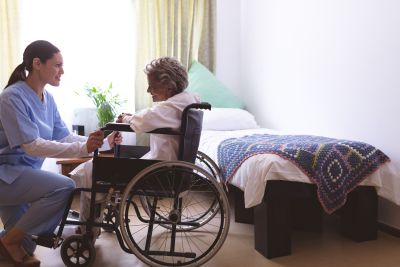Nursing home residents account for approximately 40% of deaths from SARS-CoV-2. Mehta, et al. (2021) sought to identify risk factors for SARS-CoV-2 incidence, hospitalization, and mortality among nursing home residents in the US.
Design, Setting, and Participants This retrospective longitudinal cohort study was conducted in long-stay residents aged 65 years or older with fee-for-service Medicare residing in 15,038 US nursing homes from April 1, 2020, to Sept. 30, 2020. Data were analyzed from Nov. 22, 2020, to Feb. 10, 2021.
The main outcome was risk of diagnosis with SARS-CoV-2 (per International Statistical Classification of Diseases, Tenth Revision, Clinical Modification [ICD-10-CM] codes) by September 30 and hospitalization or death within 30 days after diagnosis. Three-level (resident, facility, and county) logistic regression models and competing risk models conditioned on nursing home facility were used to determine association of patient characteristics with outcomes.
Among 482,323 long-stay residents included, the mean (SD) age was 82.7 (9.2) years, with 326,861 (67.8%) women, and 383,838 residents (79.6%) identifying as White. Among 137,119 residents (28.4%) diagnosed with SARS-CoV-2 during follow up, 29,204 residents (21.3%) were hospitalized, and 26,384 residents (19.2%) died within 30 days. Nursing homes explained 37.2% of the variation in risk of infection, while county explained 23.4%. Risk of infection increased with increasing body mass index (BMI; calculated as weight in kilograms divided by height in meters squared) (eg, BMI>45 vs BMI 18.5-25: adjusted hazard ratio [aHR], 1.19; 95% CI, 1.15-1.24) but varied little by other resident characteristics. Risk of hospitalization after SARS-CoV-2 increased with increasing BMI (eg, BMI>45 vs BMI 18.5-25: aHR, 1.40; 95% CI, 1.28-1.52); male sex (aHR, 1.32; 95% CI, 1.29-1.35); Black (aHR, 1.28; 95% CI, 1.24-1.32), Hispanic (aHR, 1.20; 95% CI, 1.15-1.26), or Asian (aHR, 1.46; 95% CI, 1.36-1.57) race/ethnicity; impaired functional status (eg, severely impaired vs not impaired: aHR, 1.15; 95% CI, 1.10-1.22); and increasing comorbidities, such as renal disease (aHR, 1.21; 95% CI, 1.18-1.24) and diabetes (aHR, 1.16; 95% CI, 1.13-1.18). Risk of mortality increased with age (eg, age >90 years vs 65-70 years: aHR, 2.55; 95% CI, 2.44-2.67), impaired cognition (eg, severely impaired vs not impaired: aHR, 1.79; 95% CI, 1.71-1.86), and functional impairment (eg, severely impaired vs not impaired: aHR, 1.94; 1.83-2.05).
These findings suggest that among long-stay nursing home residents, risk of SARS-CoV-2 infection was associated with county and facility of residence, while risk of hospitalization and death after SARS-CoV-2 infection was associated with facility and individual resident characteristics. For many resident characteristics, there were substantial differences in risk of hospitalization vs mortality. This may represent resident preferences, triaging decisions, or inadequate recognition of risk of death.
Reference: Reference: Mehta HB, et al. Risk Factors Associated With SARS-CoV-2 Infections, Hospitalization, and Mortality Among US Nursing Home Residents. JAMA Netw Open. 2021;4(3):e216315. doi:10.1001/jamanetworkopen.2021.6315

Be the first to comment on "Risk Factors Associated With SARS-CoV-2 Infections, Hospitalization and Mortality Among U.S. LTCF Residents"